True Bugs
by Valerie (October 30, 2001)

There are lots of species of true bugs in our area; they are members of the order Hemiptera. Some are so unique that they've already been covered in previous articles: the ant-mimicking bugs and the water striders. The variety of these insects is astounding, with colors ranging from dull gray to brilliant reds and yellows, brown and green, size ranging from very tiny to about an inch long, and feeding habits ranging from vegetarian to insectivorous to carnivorous. The life cycle of true bugs is an incomplete metamorphoses, with the eggs hatching into nymphs that molt about five times before achieving adult features. The stages through which the nymphs pass are called instars. In general, bugs have several characteristics. Their mouth parts are designed for piercing and sucking, whether it is plant juices, insect fluids or vertebrate blood. The name Hemiptera means "half" and "wing" referring to the structure of their front pair of wings which have a thick, leathery base portion and a thin membranous outer part. Bugs are easily recognized by the triangular plate on their thorax between their wings; this is called a scutellum. 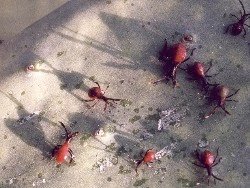
Since many true bugs feed by sucking plant juices, they are major pests on certain types of crops. We avoid the largest problems by not growing fleshy edible vegetables and fruits, but the bugs do love our cactuses. The spineless prickly pears are constantly plagued with groups of bugs, which don't seem to do a lot of harm, but their feeding leaves unsightly scars and residue on the skin of the plants. The bugs that prefer the cactuses are a type of stink bug; a group of the nymphs are pictured at left. They often try to infest various other species of cactus that I grow in a small raised bed but I am fairly diligent about removing both the young and the adults. The adults are a dull gray color and smell absolutely horrible, while the nymphs are brightly colored, tend to stay in groups and don't have a noticeable odor.
Many types of bug nymphs stay in groups when they are young and I've sometimes found large numbers of newly hatched bugs clustered in small areas. Their bright color is probably a warning that they are foul-tasting (or pretending to be) and a large group of them is a more effective deterrent than lone individuals. There is also frequently a surprising difference in the appearance of nymphs and adults. Some are shaped pretty much the same but the colors vary. This is the case with the green stink bug, an adult of which is pictured above at left and a nymph below at left. One of the most noticeable variations occurs in the broad-headed bugs of the family Alydidae. While the adults look like slender typical bugs, the nymphs bear a remarkable resemblance to ants.
Although I can't always identify bugs by species, it is fairly easy to figure out the group to which they belong. I often find slender, immature predatory bugs such as that pictured at right. These are assassin bugs and are quite beneficial since they eat many insect pests. Other names for this type of bug are damsel bug, conenose, masked hunter and kissing bug. An interesting anatomical feature of the assassin bugs in our area is the structure of their antennae, which are quite long, with few segments, bending like legs. These bugs ambush their victims and can often be found around flowers or other places that insects are likely to frequent. The assassin bug shown below is located under a rose blossom.
One of the largest bugs we have is the yucca plant bug, or leaffooted bug. These 1-inch long brown insects are very noisy when they fly and seem to be quite catholic in their feeding preferences. The may feed on various seed pods as well as other parts of numerous plants, and I even frequently find them on the trunk of an ash tree. A top view of this insect can be seen on a hyacinth bean pod, while the one at right is on castor bean pods.
Another very large bug is the wheel bug. Aptly named for the cogwheel type structure on its back, this bug is predatory. They seem to have preferred territories, as I can often find one in the same place for several weeks. Our jimsonweed plants are favorite hang-outs for these insects. While I've never experienced it personally, the bite of a wheel bug is supposed to be extremely painful.
|

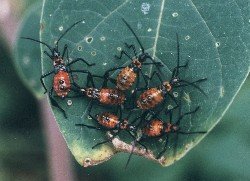
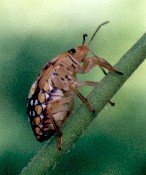
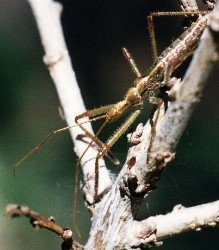
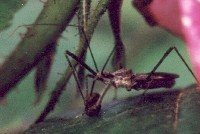

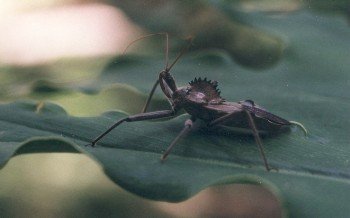
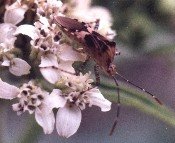
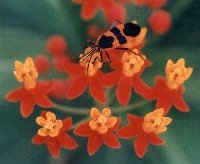 Some bugs are interesting, but are neither beneficial nor harmful pests. They may help pollinate flowers because they seem to always be found in blossoms. One such insect is the coreid bug pictured at right on frostweed blossoms. It is fairly small, being only a little over ½ inch long. Another type of bug which is very pretty is the milkweed bug, one species being pictured here on the blossoms of butterflyweed. These brightly colored insects are usually black and anything from cream colored to red. They remind me of box elder bugs but are always found on milkweed flowers.
Some bugs are interesting, but are neither beneficial nor harmful pests. They may help pollinate flowers because they seem to always be found in blossoms. One such insect is the coreid bug pictured at right on frostweed blossoms. It is fairly small, being only a little over ½ inch long. Another type of bug which is very pretty is the milkweed bug, one species being pictured here on the blossoms of butterflyweed. These brightly colored insects are usually black and anything from cream colored to red. They remind me of box elder bugs but are always found on milkweed flowers.